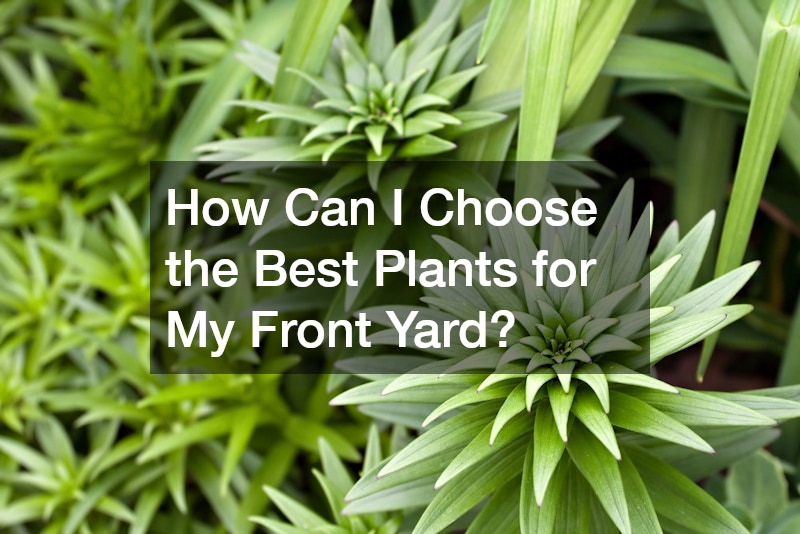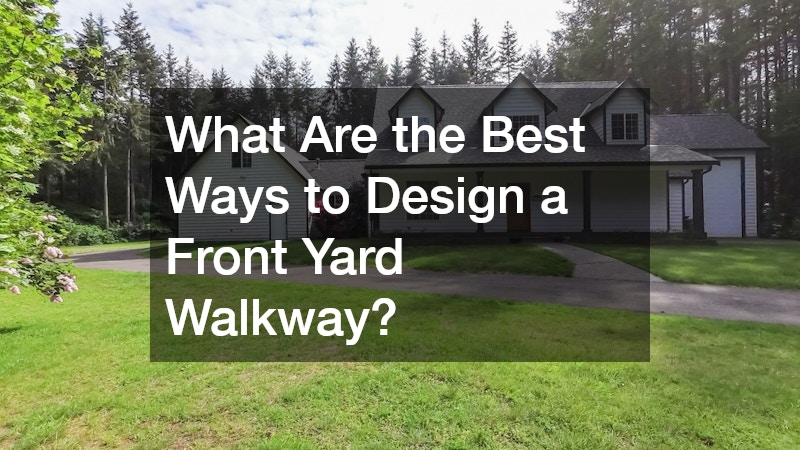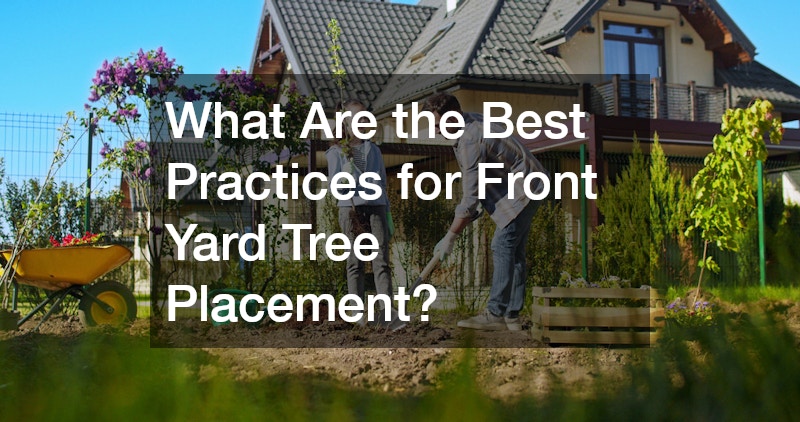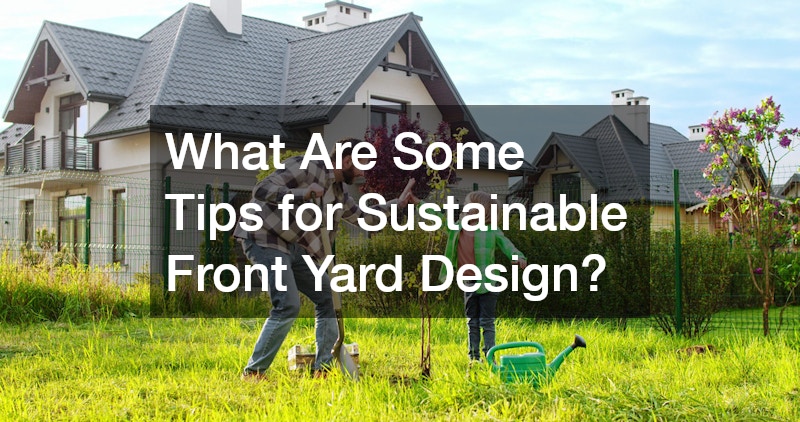Enhancing the look of your home’s exterior starts with a well-designed front yard. Whether you have a small entryway garden or a spacious lawn, thoughtful planning can turn the space into a welcoming, stylish reflection of your home’s character. With the right combination of plants, materials, lighting, and layout, your front yard can elevate curb appeal while providing long-lasting function and charm. From selecting plants that thrive in your environment to integrating modern hardscaping and lighting, there are countless ways to make your outdoor space stand out.
How Can I Choose the Best Plants for My Front Yard?

Understanding Your Climate
The first step in designing a front yard that thrives year-round is understanding your local climate. Choosing plants that match your region’s weather conditions ensures they grow healthily with minimal effort. For example, drought-tolerant varieties like lavender and succulents are ideal for arid areas, while ferns and hydrangeas flourish in humid, shaded environments. Assessing your hardiness zone will help you identify plants best suited for your area, reducing maintenance needs and enhancing overall landscape sustainability.
Low-Maintenance Plant Options
Homeowners often prefer low-maintenance plants that offer visual appeal without requiring constant care. Perennials such as daylilies, coneflowers, and ornamental grasses provide vibrant color and texture throughout multiple seasons. Incorporating evergreen shrubs helps maintain structure and greenery even during colder months. A mix of these hardy plants creates depth and ensures your front yard looks attractive with minimal upkeep.
Seasonal Blooms and Foliage
Integrating plants that bloom at different times of the year ensures continuous visual interest. Spring bulbs, summer annuals, and fall foliage plants can create an ever-changing landscape that reflects the natural rhythm of the seasons. Using varying leaf colors and textures also adds dimension, making your garden look lively and thoughtfully designed all year.
Incorporating Native Plants
Native plants are a cornerstone of sustainable design. Because they are adapted to your region, they require less water and fertilizer, resist local pests, and support pollinators. They also blend harmoniously with the surrounding environment, creating a cohesive, natural aesthetic that enhances curb appeal while promoting biodiversity.
Utilizing Planters and Containers
Planters and containers are a versatile way to add greenery to patios, entryways, and along walkways. They allow flexibility in changing your plant displays seasonally and can be easily relocated as needed. Containers also highlight architectural details or complement the home’s color scheme, giving the front yard a polished, intentional look.
What Are Some Budget-Friendly Landscaping Ideas?
DIY Landscaping Techniques
Creating a beautiful yard doesn’t have to be expensive. Many homeowners use DIY landscaping techniques to save on labor costs. Simple projects like installing a small retaining wall with stacked stones or creating a gravel path can add structure and appeal without professional intervention. Gathering your own landscaping supplies from local sources can further reduce costs while supporting nearby businesses.
Repurposing Materials
Recycling materials is an excellent way to achieve a stylish front yard on a budget. Old bricks, reclaimed wood, or leftover stone flooring can be repurposed into planters, borders, or pathways. This not only saves money but also adds rustic charm and sustainability to your design.
Affordable Plant Choices
Opting for plants that spread quickly or can be easily propagated—such as hostas, ground covers, or sedum—can help fill out spaces economically. Buying smaller plant sizes and allowing them to mature over time is another budget-friendly approach that still delivers a lush final look.
Creating a Pathway with Recycled Elements
Pathways made from broken concrete, old pavers, or gravel can lead guests naturally through your garden while maintaining a low-cost aesthetic. When combined with greenery and lighting, these pathways offer functionality and enhance the yard’s overall structure.
Incorporating Mulch and Ground Cover
Mulch and low-growing ground covers help prevent weeds and retain soil moisture, reducing maintenance costs over time. They also provide a clean, cohesive appearance that ties all elements of your landscape together.
How Can I Improve Curb Appeal with Lighting?
Choosing Pathway Lighting
Proper lighting enhances both safety and beauty. Pathway lighting guides guests toward your entryway, prevents tripping hazards, and creates an inviting nighttime ambiance. Solar-powered lights are popular for their easy installation and energy efficiency.
Accent Lighting for Focal Points
Use accent lighting to highlight architectural features, specimen trees, or water elements. Up-lighting a beautiful tree or adding a subtle glow to stone flooring along your walkway draws attention to key design aspects and elevates the overall atmosphere.
Solar Lighting Options
Solar lighting offers convenience and sustainability. Modern designs are available in various styles, from sleek stainless steel fixtures to warm lanterns, allowing you to customize the aesthetic while minimizing energy costs.
Integrating Smart Lighting Technology
Smart lighting systems can be controlled remotely, adjusting brightness and timing according to your schedule. This innovation allows homeowners to save energy while maintaining the perfect mood for outdoor gatherings or nighttime curb appeal.
LEDs vs. Traditional Bulbs
LEDs have become the standard for outdoor lighting thanks to their long lifespan and low energy consumption. They provide bright, consistent illumination, making them ideal for pathways, porches, and accent lighting throughout the yard.
What Are the Best Ways to Design a Front Yard Walkway?

Selecting Materials and Styles
Walkway materials can dramatically impact your front yard’s look. Choices like natural stone, brick, or concrete pavers create distinct aesthetics. Stone flooring offers timeless elegance, while concrete and paver combinations provide modern appeal. Selecting colors and textures that complement your home’s exterior ensures visual harmony.
Designing for Functionality
A well-designed walkway should balance beauty with practicality. Ensure paths are wide enough for comfortable access and incorporate smooth transitions for safety. Gentle curves create a sense of movement, guiding the eye toward focal points like a front porch or garden centerpiece.
Adding Curves and Interest
Curved walkways break up linear monotony, giving your yard a softer, more organic flow. These shapes pair well with hardscaping elements such as planters, small retaining walls, or decorative stones.
Incorporating Landscaping Around Walkways
Framing walkways with plants or mulch softens hard edges and integrates pathways into the surrounding landscape. Layering plants of different heights creates depth and texture that enhances visual balance.
Maintaining a Durable Path
Regular maintenance ensures your walkway remains safe and attractive. Keep pathways clear of debris and consider applying an epoxy coating on concrete or stone flooring to protect against weathering and stains.
How to Incorporate Water Features into Front Yard Design?
Choosing the Right Fountain
A fountain can become the focal point of your front yard. Whether you prefer a modern tiered design or a rustic stone feature, the gentle sound of flowing water adds tranquility and elegance.
Designing a Pond or Stream
For larger spaces, small ponds or streams introduce natural movement and visual interest. They can be bordered with native plants or stones for a cohesive, serene environment.
Waterfall Considerations
A cascading waterfall enhances the auditory and visual appeal of your yard. Combined with strategic lighting, it becomes an enchanting nighttime feature that boosts curb appeal.
Maintenance and Upkeep of Water Features
Keeping water clean and equipment in good condition ensures longevity. Regular cleaning and checking pump systems prevent algae buildup and maintain clear, sparkling water.
Integrating Water Features with Lighting
Illuminating water features enhances their beauty at night. Underwater LEDs or spotlights can create dramatic effects that bring your front yard to life after dark.
What Are the Best Practices for Front Yard Tree Placement?

Understanding Tree Growth and Space
Selecting trees involves more than choosing your favorite type. Consider their mature size and root spread to avoid interference with foundations or pathways. Proper spacing ensures healthy growth and prevents overcrowding.
Creating Shade and Privacy
Trees provide natural shade and privacy, especially when placed near seating areas or windows. Species like maples or oaks offer broad canopies, while evergreens provide year-round coverage.
Tree Types for Different Climates
Choose species suited to your local environment. Native trees often perform best, requiring less maintenance and offering resilience to pests and weather extremes.
Enhancing Landscapes with Fruit Trees
Fruit trees not only provide beauty and shade but also add functionality by yielding fresh produce. Integrating them near pathways or garden borders merges practicality with design.
Maintaining Tree Health
Regular pruning, mulching, and watering help trees thrive. Monitoring for pests and disease ensures long-term health and visual appeal.
How to Add Color to Your Front Yard?
Seasonal Flower Choices
Select flowers that bloom in different seasons to maintain a colorful yard year-round. Petunias, tulips, and chrysanthemums create bright bursts of color that attract pollinators and visitors alike.
Using Painted Accents and Decor
Painted planters, benches, or even gates add artistic personality to your landscape. Choose colors that complement your flowers and home exterior for a cohesive design.
Multi-Colored Foliage Options
Variegated plants with different leaf tones provide year-round color even when flowers fade. Pairing them with textured hardscaping elements amplifies contrast and visual depth.
Creating Colorful Borders
Define garden beds or walkways with colorful edges made from flowering ground covers or painted stones. These details subtly guide the eye through the landscape.
Combining Warm and Cool Colors
Mixing warm tones like reds and yellows with cool blues and purples creates balance and vibrancy. A thoughtful palette can evoke specific moods, from calming to energizing.
What Are Some Tips for Sustainable Front Yard Design?

Xeriscaping Principles
Xeriscaping focuses on water-efficient landscaping through drought-tolerant plants, gravel beds, and strategic design. It minimizes water usage while maintaining aesthetic appeal.
Eco-Friendly Material Choices
Using sustainable materials such as reclaimed wood, recycled pavers, and locally sourced stone reduces your carbon footprint. Many patio builder professionals now specialize in eco-conscious installations that combine beauty with responsibility.
Water Conservation Strategies
Rain barrels, drip irrigation, and soil amendments help maximize water efficiency. Grouping plants with similar water needs further reduces waste and maintenance.
Implementing a Pollinator Garden
Pollinator gardens attract bees, butterflies, and hummingbirds while enriching the ecosystem. Using native flowers supports biodiversity and encourages natural growth patterns.
Composting and Soil Replenishment
Composting organic waste provides nutrient-rich soil that enhances plant growth. It’s a cost-effective way to maintain a healthy landscape sustainably.
How to Incorporate Edible Landscapes?
Combining Aesthetics with Functionality
Edible landscapes blend beauty and practicality. Herbs, vegetables, and fruit trees can be arranged as ornamental features, adding texture and variety to your yard.
Choosing Edible Plants and Herbs
Consider plants like rosemary, kale, and strawberries, which offer both visual appeal and fresh produce. Their versatility makes them ideal for decorative garden beds.
Designing with Raised Beds
Raised beds improve drainage and make gardening more accessible. Construct them with durable materials like wood or stone to complement your existing landscape.
Vertical Garden Ideas
Vertical gardens maximize limited space and create striking green walls. They can be mounted near entryways or along fences, especially wood fencing, to add lushness and charm.
Integrating Edibles into Existing Landscapes
Blend edible plants among ornamental species to create a seamless transition. This approach allows homeowners to enjoy fresh ingredients without sacrificing design quality.
What Are Innovative Lawn Alternatives?
Choosing Ground Covers Over Grass
Low-maintenance ground covers like creeping thyme or clover offer greenery without the constant mowing and watering grass requires. They also add texture and variety to your yard.
Integrating Hardscape Features
Hardscaping, such as stone patios, pathways, and decorative borders, replaces water-intensive lawns with durable, stylish elements. Combining these features with a small retaining wall or decorative rocks enhances structure and reduces upkeep.
Creating Artificial Turf Areas
For homeowners seeking a lush, green look year-round, artificial turf services provide a realistic and low-maintenance solution. Modern turf mimics natural grass beautifully while conserving water and eliminating mowing.
Implementing Larger Flower Beds
Expanding flower beds adds visual diversity and reduces the amount of turf area to maintain. These beds can frame walkways or line fences for a balanced, cohesive layout.
Transforming Lawn Spaces into Activity Zones
Redesigning open areas for social or recreational use can replace traditional lawns. Incorporating seating, gates, and durable surfaces like epoxy coating for patios can turn your front yard into a multifunctional gathering space.
Transforming your front yard is an investment in your home’s beauty, functionality, and value. By choosing climate-appropriate plants, integrating sustainable materials, and balancing softscapes with hardscapes, you can create a space that welcomes guests and enhances curb appeal. Whether you partner with skilled fence companies, a trusted patio builder, or rely on high-quality landscaping supplies, every detail contributes to a unified design. From elegant stone flooring and wood fencing to eco-friendly artificial turf services, your front yard can embody both sophistication and sustainability—making your home truly stand out in the neighborhood.



